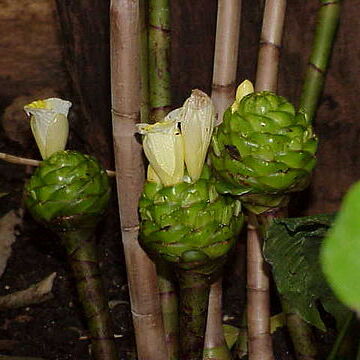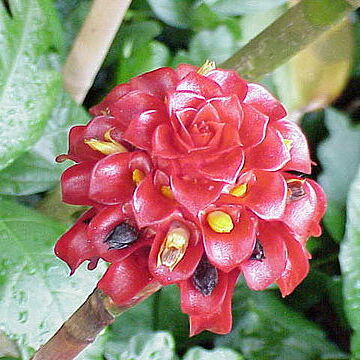Herbs perennial, terrestrial, not aromatic, with ± fleshy rhizomes. Stems usually simple, often long, terete, sometimes spirally contorted, leafy; secondary branches (if present) breaking through leaf sheaths. Leaves spirally arranged, simple, those toward base of stem usually bladeless; leaf sheath tubular, closed; ligule present; petiole short; leaf blade narrowly to broadly elliptic, rolled longitudinally in bud, glabrous or hairy, margin entire. Inflorescence a conelike spike, terminal on leafy shoots or on separate, short, leafless shoots arising from rhizomes; bracts imbricate, with linear, nectariferous callus below apex, 1-or 2-flowered; bracteoles tubular or folded. Flowers bisexual, epigynous, zygomorphic. Calyx tubular, 2-or 3-lobed or-toothed. Corolla proximally tubular, distally 3-lobed; lobes unequal, imbricate in bud. Staminodes 5, united into a labellum equaling or much longer than corolla, often ± 3-lobed with crisped margin, never deeply lobed. Fertile stamen 1; filament broad; anther borne below apex of filament or at apex with a connective crest, introrse, dehiscing by longitudinal slits. Ovary inferior, 2-or 3-loculed; ovules many per locule; placentation axile. Developed style 1, filiform, usually enclosed between anther locules; stigma with or without abaxial appendage. Stylodes 2, reduced to septal, hollow nectaries at apex of ovary, or absent. Fruit a capsule, 2-or 3-valved and dehiscing loculicidally, or indehiscent and breaking up irregularly, apex with persistent calyx. Seeds numerous, black, arillate.
More
Rhizomatous herbs lacking aromatic oil cells; rhizome fleshy, sympodial, each element terminating in a leafy or flowering shoot. Leaves few to many, arranged spirally, ligulate; sheaths tubular. Inflorescence occasionally surrounded by sterile bracts, terminal on leafy shoots or borne directly on rhizome. Flowers bisexual, solitary in the axils of bracts or in pairs, with or without bracteoles. Calyx tubular, often unilaterally split. Corolla tube often exceeding calyx, divided into 3 sub-equal lobes. Labellum (anterior staminode) adnate at base to corolla tube, conspicuous or inconspicuous; lateral staminodes absent or tooth-like. Fertile stamen 1; filament petaloid; thecae usually well-separated. Style linear, held between anther-thecae; stigma expanded; ovary inferior, trilocular, rarely bilocular, with axile placentation; 3 septal nectary glands present towards top of ovary. Fruit a dehiscent capsule, sometimes breaking up irregularly. Seeds arillate.


